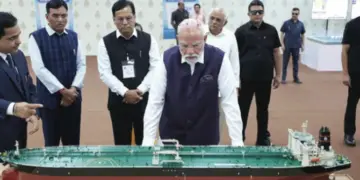The recent incident in Handwara, where locals had to carry a woman and her newborn on their shoulders through heavy snowfall, is a stark reminder of the deep chasm between political rhetoric and governance realities in Jammu and Kashmir. While governments often showcase infrastructure and development projects as symbols of progress, this heart-wrenching episode underscores the dire need for action that directly alleviates the hardships faced by ordinary people.
It is not just a tragic story – it’s a damning indictment of winter preparedness in Kashmir. This single incident captures the essence of decades-long neglect by authorities who equate preparedness with snowplows and salt trucks while ignoring the human cost of their indifference.
Winter Preparedness or a Snow Clearing Contest?
In Kashmir, “winter preparedness” is a fancy term for clearing snow off main roads – and that too inconsistently, and mostly in urban than rural areas. Beyond these cosmetic efforts, no thought is given to keeping hospitals accessible, ensuring power supply, or making life livable during harsh winters. The administration seems to believe that as long as snowplows are running, the job is done. But winter preparedness means much more. It means guaranteeing that people don’t risk their lives carrying patients through snowdrifts. Has the government ever thought of this? Likely not – they’re too busy clearing snow from their office driveways, and weaving cobwebs of useless banter in their minds. And if it is only about removing snow, then:
How Many Snowplows Does Kashmir Need?
As of December 2024, Srinagar, the capital city of Jammu and Kashmir, has deployed 45 snow clearance machines to manage winter snowfall. These machines are primarily allocated to critical routes. While this allocation addresses urban needs, information about the number of snowplows available in rural areas of Kashmir is limited. The effectiveness of snow clearance in these regions often depends on the availability and deployment of machinery, which can vary based on local administrative resources and infrastructure.
Kashmir likely needs at least 500-700 snow-clearing machines to ensure comprehensive winter preparedness. This includes a mix of plows, blowers, and specialized equipment tailored for its diverse geography. Here is an approximate estimate of requirements:
Urban Needs: At least 100 snowplows to maintain road connectivity in cities and towns, including arterial roads.
Rural Needs: A minimum of 300-500 snowplows, considering the widespread rural population and difficult terrain.
Highways and Major Routes: Dedicated fleets of 50-100 heavy-duty machines for major highways and vital routes.
What Winter Preparedness Looks Like Elsewhere
Countries with severe winters have turned preparedness into an art. In Canada, snowplows operate even before storms hit, ensuring roads remain navigable. Norway’s hospitals are equipped with “winter rooms” to cater to patients during blizzards, and snowmobiles ensure emergency evacuations in remote areas. Finland’s district heating systems keep homes and public buildings warm efficiently, while Japan’s heated roads prevent snow accumulation altogether. Heated roads? We don’t have electricity to power our electric blankets – so forget it. These countries understand that winter preparedness isn’t just about removing snow – it’s about safeguarding lives and maintaining dignity. We have no dignity; so we be damned!
Hospitals Closer, Not Farther
Kashmir’s healthcare infrastructure, especially in winter, is a cruel joke. Hospitals are too far for emergencies, and primary health centers are poorly equipped. This article won’t talk about helicopter services because that will be considered a joke. But what stops the government from upgrading facilities and ensuring healthcare is within reach, even during heavy snowfall? Perhaps it’s because they’re busy thinking about issues that don’t matter – like drafting another irrelevant press release, scoring an oral point against the opponent, and picking on our heads like hudhuds beating the insects dead.
Why the Government Misses the Point
The Jammu and Kashmir government’s failure (all governments so far, including the one commanded from the center) to think beyond surface-level solutions stems from its misplaced priorities. Instead of focusing on meaningful changes, they’re busy addressing frivolous issues that add no value to people’s lives. Winter preparedness requires a comprehensive plan – one that ensures roads remain passable, healthcare is accessible, power is stable, and essential supplies don’t vanish. Sadly, such foresight seems absent.
A Final Thought
The Handwara tragedy is not an isolated incident; it’s the grim reality of winters in Kashmir. While officials enjoy the warmth of their gas-heated offices, ordinary people fight for survival. Winter preparedness in Kashmir isn’t just inadequate – it’s nonexistent. Until the government stops wasting its energy on irrelevant distractions and starts addressing real issues, the burden of preparedness will continue to fall on the shoulders of Kashmir’s people – literally. And any leader who thinks winter preparedness is just snowplowing – beg your pardon it is not. Update yourself.




